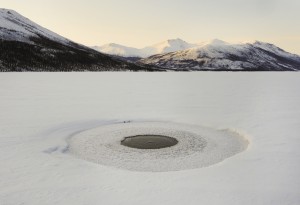Study: Geologic methane seeping from thawing cryosphere
May 21, 2012

907-474-7902
5/21/12
Geologic methane is seeping through the edges of thawing permafrost and receding glaciers in Alaska and Greenland, according to a study recently published in the journal Nature Geoscience.
University of Alaska Fairbanks researcher Katey Walter Anthony led the study, which, for the first time, documents the widespread occurrence of these terrestrial sources of geologic methane seepage in the Arctic.
“They had never before been quantified and we didn’t know they were so widespread,” she said.
In the past, researchers have found that, as permafrost thaws, previously frozen organic matter like dead plants or animals decays and releases methane.
“Now we are saying that as permafrost thaws and glaciers retreat it is going to let something out that has had a lid on it,” Walter Anthony said.
In the Arctic, that lid is known as the “cryosphere cap.” It’s made up of glaciers, permafrost and ice sheets, which are thought to keep geologic sources of methane—such as coal beds and natural gas deposits—from venting into the atmosphere. However, as permafrost thaws and glaciers retreat, this cap can develop leaks, allowing the methane to escape.
Walter Anthony and her team saw this manifested in Alaska and Greenland lakes, where rapidly rising methane plumes created patches of open water in otherwise frozen bodies of water. In order to quantify the phenomenon, the researches flew across the state of Alaska, from the Kenai Peninsula to the North Slope, during the winters of 2008 through 2010, and hiked across lakes in Greenland during the winter of 2010. They surveyed nearly 7,000 lakes from the air and identified 77 of them that were very likely to have sites where methane was seeping. Then, the scientists visited 50 of the lakes to confirm the presence of seeps and take samples of the gas boiling up from under the water. They later tested the samples and determined the gas’s source was geologic, rather than the result of decaying organic material. The majority of the seeps were in the continuous permafrost zone in northern Alaska and in Southcentral Alaska, where glaciers were receding. In Greenland, the seeps were found only in the areas where the ice sheet had retreated during the past 150 years.
Methane is important in the global climate picture because it is a potent greenhouse gas. It is more than 20 times more effective at trapping atmospheric heat than carbon dioxide.
Walter Anthony said that according to the data from this study, geologic methane seeps in Alaska’s terrestrial environment may contribute about 250,000 metric tons of methane to the atmosphere each year. In comparison, Walter Anthony estimates that organic decay in Alaska’s lake bottoms contributes about three times that amount. However, she noted that those numbers don’t include microseeps of geologic methane, which could mean geologic sources roughly equal the organic sources.
“When the glaciers retreat or the permafrost thaws,” she said, “it creates conduits for deeper gas to make its way up through the Earth.”
And those conduits could become more widespread if worldwide
temperatures continue to increase, Walter Anthony notes. “In a warmer world, thawing permafrost and wastage of glaciers and ice sheets could lead to a significant transitional degassing of subcap methane.”
Co-authors on the paper include Peter Anthony and Guido Grosse, also of UAF, and Jeffrey Chanton of Florida State University.
NOTES TO EDITORS: Walter Anthony is out of the office but will be available at an audioconference press briefing at noon Alaska time, (4 p.m. Eastern) on Monday, May 21. Dial 800-893-8850. The PIN is 1211736. Media outside the U.S./Canada can dial +001-503-295-8000. You will be prompted to enter the 800 number and PIN.
Please contact Grimes to arrange interviews with Walter Anthony.
To download additional photos, the audioconference recording and a video, visit our FTP site at ftp://cinema.wfb.uaf.edu. Cutlines are available in the multimedia guide.
Username: uafnews
Password: multimedia
Folder: UAFmultimedia
ON THE WEB: http://ine.uaf.edu/werc/people/katey-walter-anthony/
MG/5-21-12/252-12


